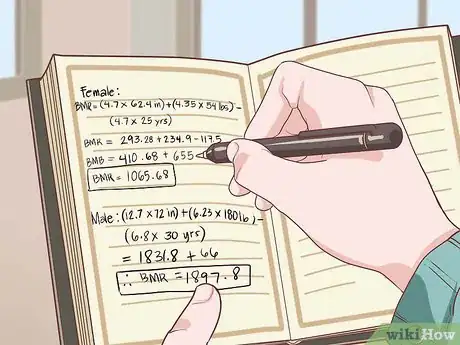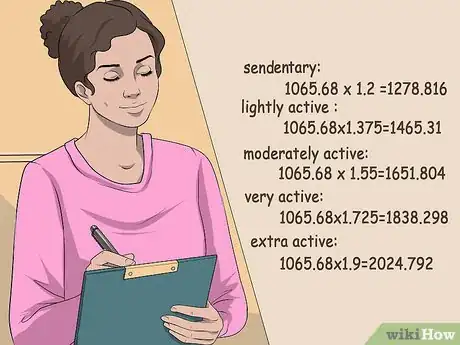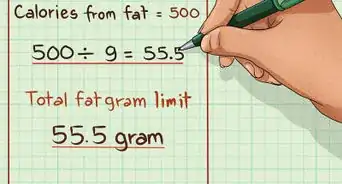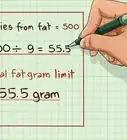This article was co-authored by Claudia Carberry, RD, MS. Claudia Carberry is a Registered Dietitian specializing in kidney transplants and counseling patients for weight loss at the University of Arkansas for Medical Sciences. She is a member of the Arkansas Academy of Nutrition and Dietetics. Claudia received her MS in Nutrition from the University of Tennessee Knoxville in 2010.
There are 11 references cited in this article, which can be found at the bottom of the page.
This article has been viewed 309,279 times.
A calorie is a unit of energy that your body uses to function and perform daily life sustaining activities. The calories you eat from foods provides your body with energy. Everyone's daily caloric needs are different based on age, height, weight, gender, lean body mass and activity level.[1] When you know how to calculate your total daily calorie needs, you can design an eating plan to help meet your health goals.
Steps
Calculating Your Total Calorie Needs
-
1Use an online calculator. You can calculate your total calorie needs with the number of available online calculators.[2]
- These may be easier to use and less complicated than doing the required mathematical equations yourself.
- You can find a variety of calculators from weight loss and wellness clinics and some medical associations' websites. Make sure you're choosing a reliable website and do not use calculators from blogs or other personal sites.
- Most of these calculators operate in the same way. You'll input your height, weight, gender, age and activity level. Have this information handy when you calculate your needs.
-
2Determine your basal metabolic rate or BMR by equations. Your BMR is the amount of calories your body requires just to perform daily, life sustaining functions. It's the rate of your metabolism or the amount of calories your body burns at rest.[3]
- Your body needs a set number of calories just to stay alive and function normally. Anything from keeping your heart beating, breathing or digesting food requires energy in the form of calories. It accounts for the largest amount of total calories burned each day.[4]
- The BMR equation for the average American woman is: (4.7 x your height in inches) + (4.35 x your weight in pounds) - (4.7 x your age in years). Add 655 to this total for the BMR..
- The BMR equation for the average American man is: (12.7 x your height in inches) + (6.23 x your weight in pounds) - (6.8 x your age in years). Add 66 to the total for the BMR.
- You will use your BMR in the Harris Benedict equation to find out how many calories you burn with activity included.
Advertisement -
3Calculate your total energy expenditure using the Harris Benedict Equation. The Harris Benedict Equation can help you calculate an estimate of how many calories you burn each day by multiplying your BMR by your average activity level.[5]
- Multiply your BMR by your activity level. This will give you a fairly accurate number for your daily total caloric intake.
- If you're sedentary (little to no exercise) multiply your BMR by 1.2.
- If you are lightly active (exercising about 1-to-3 days each week), multiply your BMR by 1.375.
- If you are moderately active (exercising moderately and/or play sports 3-to-5 days) multiply your BMR by 1.55.
- If you are very active (people who engage in strenuous sports or hard exercise 6-to-7 days a week) multiply your BMR by 1.725.
- If you are extra active (people who engage in very physically challenging jobs or exercise, such as 2-a-day workouts) multiply your BMR by 1.9.
-
4Consider body fat percentage. More muscular bodies or people that have low body fat and high levels of lean muscle may need more daily calories than more average people.
- If you're an athlete or naturally have a lower body fat percentage, you may need more calories than predicted by online calculators or mathematical equations.
- Lean muscle mass burns more calories than fat mass. Eating a small amount more may help you reach a more appropriate calorie goal.
- Also note that overweight or obese people may overestimate daily calories with the Harris Benedict formula.
Using Your Total Calorie Needs to Manage Your Health
-
1Make an appointment with a registered dietitian. These nutrition experts will be able to give you more specific recommendations about your calorie needs. They will also be able to tell you how to use your daily calorie needs to help manage your health. It is especially important to meet with a dietitian if you have any health conditions or medical issues that need to be taken into account.[6]
- You may need to look up local dietitians online or ask your primary care physician for a referral to a local dietitian. The Academy of Nutrition and Dietetics has a "Find an Expert" feature on their website to help you search.[7]
- Many dietitians have different focus areas. If you're interested in a specific topic - like weight loss, eating for athletic performance or managing chronic health conditions - look for dietitians that focus in that specialty.
-
2Use your total calorie needs to lose weight. Many people want to figure out how many calories they burn each day to help them lose weight. Adjust your recommended intake to help support your goal.[8]
- If you want to lose weight, it's typically recommended to cut out about 500 calories daily to result in safe weight loss (losing 1-2 pounds weekly).[9]
- Cutting out more calories is typically not recommended. If you don't eat enough your weight loss may slow and you're at a higher risk for nutrient deficiencies.
-
3Add calories to gain weight. If you and your doctor or dietitian decide that you need to gain weight, you can also use your total daily calorie needs to help you gain weight.[10]
- Health professionals recommended consuming an extra 250-500 calories daily. This will result in about 1/2-1 pound weight gain each week.
- To maintain your weight, try to keep calories within the range predicted by your calculations.
- If you notice unwanted weight loss or weight gain, revisit your total caloric intake and adjust as necessary.
Daily Calorie Calculator
References
- ↑ https://www.nhs.uk/live-well/healthy-weight/managing-your-weight/understanding-calories/
- ↑ https://www.calculator.net/calorie-calculator.html
- ↑ https://www.k-state.edu/paccats/Contents/PA/PDF/Physical%20Activity%20and%20Controlling%20Weight.pdf
- ↑ http://www.betterhealth.vic.gov.au/bhcv2/bhcarticles.nsf/pages/Metabolism_explained?open
- ↑ https://www.diabetes.co.uk/bmr-calculator.html
- ↑ https://www.eatright.org/food/nutrition/dietary-guidelines-and-myplate/how-many-calories-do-adults-need
- ↑ http://www.eatright.org/
- ↑ https://www.cdc.gov/healthyweight/physical_activity/index.html
- ↑ https://medlineplus.gov/ency/patientinstructions/000892.htm
About This Article
To calculate your total calorie needs, start by determining your basal metabolic rate by inputting your height, weight, gender, and age into an online calculator. Then, use the Harris Benedict equation, which multiplies your basal rate by your specific energy level. For example, if you’re relatively sedentary, you’ll multiply your basal rate by 1.375, but if you’re active, you’ll multiply it by 1.725. For tips from our Dietician reviewer on how to take body fat percentage into account when calculating your calorie needs, read on!









-Step-14-Version-3.webp)






















-Step-14-Version-3.webp)





































Medical Disclaimer
The content of this article is not intended to be a substitute for professional medical advice, examination, diagnosis, or treatment. You should always contact your doctor or other qualified healthcare professional before starting, changing, or stopping any kind of health treatment.
Read More...